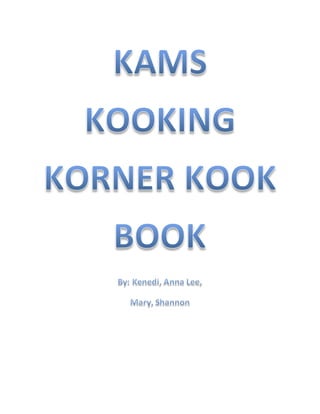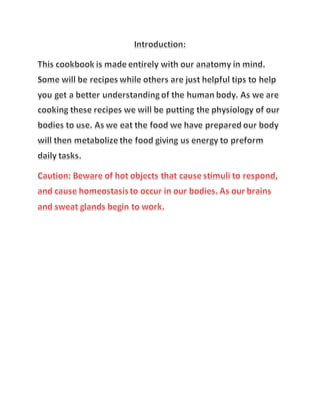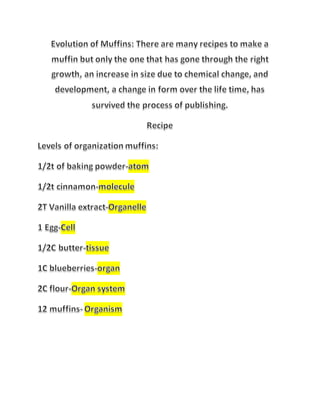1 of 5
Download to read offline





Ad
Recommended
Works Cited
Works Citedag1430bn
╠²
This document provides citations for 3 sources in MLA format. The sources include: 1) A textbook on anatomy and physiology, providing pages 4-30, published in 2003. 2) An article from Shmoop.com distinguishing organic and inorganic molecules, published in 2008. 3) A recipe for Mexican pizza from Allrecipes.com with a publication date of September 24, 2012.What can i see?
What can i see?ag1430bn
╠²
The document discusses the anatomy of the human spine and femur. It provides labeled diagrams of the vertebrae of the spine, including the first 7 vertebrae, the last 5 vertebrae, and the 12 thoracic vertebrae in between. It also shows diagrams of the ribs, their connections to the sternum and vertebrae. A second diagram labels the head, neck, greater trochanter, lesser trochanter, shaft, condyles, and other features of the human femur.Redes socialesperlanidia
╠²
Este documento resume las caracter├Łsticas y funcionalidades principales de las redes sociales. Explica que las redes sociales permiten a las personas conectarse con amigos y hacer nuevas amistades compartiendo contenido e intereses. Detalla que las primeras redes sociales datan de 1997 y que funciones populares incluyen compartir fotos y mensajear. Tambi├®n discute c├│mo las redes sociales han influido en el reclutamiento laboral y los estudios de mercado.Implants For Life- Vol 2
Implants For Life- Vol 2Shari Rene
╠²
The document discusses a new bone ring technique for vertical bone augmentation and immediate implant insertion that shortens treatment time compared to traditional two-stage augmentation, presenting a case study demonstrating the procedure. It also examines micromovements at the implant-abutment interface from different implant systems and the potential clinical relevance, and presents a rationale for esthetic tissue preservation when immediately inserting an implant after extraction by simulating a tooth replantation.Torniquetes, preparacion preoperatoria- walterMario Lopez
╠²
Le document semble incompr├®hensible ou contient des caract├©res illisibles. Il n'y a pas de contenu clair pouvant ├¬tre r├®sum├®. Aucun message coh├®rent n'est discernable.Artigo signovinces inv.8-nMarcelo Januzzi Santos .`.
╠²
Este estudo avaliou biomecanicamente e histologicamente implantes dent├Īrios cil├Łndricos e c├┤nicos em c├Żes. Os implantes c├┤nicos mostraram valores de torque de remo├¦├Żo significativamente maiores e forma├¦├Żo ├│ssea adequada em ambos os grupos nas duas semanas ap├│s a inser├¦├Żo. Os resultados indicam que ambas as macrogeometrias promovem a osseointegra├¦├Żo inicial, mas os implantes c├┤nicos melhoraram o desempenho mec├ónico.20 respiratory response1
20 respiratory response1ag1430bn
╠²
This document describes an experiment to measure changes in respiratory parameters in response to different physiological challenges: breath holding, rapid breathing, and exercise. The experiment uses a spirometer interfaced with a computer to collect tidal volume data before, during, and after each challenge. Key respiratory measurements - tidal volume, respiratory rate, and minute ventilation - are recorded and compared between the different conditions to observe how respiration is altered to maintain homeostasis in response to changes in carbon dioxide levels.Blood typing analysis
Blood typing analysisag1430bn
╠²
This document analyzes blood typing results for 4 patients: Mr. Green, Mr. Jones, Mrs. Smith, and Ms. Brown. For patient Mr. Green, the analysis found agglutination for anti-A serum, anti-B serum, and anti-Rh serum, indicating blood type AB. The document also discusses agglutinogens and agglutinins, how blood typing is performed, situations where blood typing is used, and erythroblastosis fetalis.Muscular Physiology
Muscular Physiologyag1430bn
╠²
The document contains questions and answers about skeletal muscle structure and function. It discusses topics like muscle fiber types, motor units, calcium's role in contraction and relaxation, and factors that influence muscle strength. The questions provide a quiz on key anatomical and physiological concepts in myology.Skeletal physiology 101
Skeletal physiology 101ag1430bn
╠²
The document discusses skeletal physiology, including the four types of bones, structures of long bones, constituents of bone tissue, cells found in bones, functions of bones, and bone development. It also covers cartilage structure and types, bone and cartilage growth, bone fracture repair, and joints. Key points include that long bones have a diaphysis and epiphyses, bones provide support, protection, movement, mineral storage, and blood cell formation. Cartilage includes hyaline, elastic, and fibrocartilage. Bones and cartilage both grow through cell activity but cartilage also grows through the deposition of new matrix.How do i bust sweet moves
How do i bust sweet movesag1430bn
╠²
This document provides an overview of the major bones in the human skeletal system. It includes labeled diagrams identifying the key bones in the skull, vertebral column, rib cage, shoulder, arm, hand, pelvis, thigh, leg, ankle and foot. The text also asks how an anthropologist can tell the difference between male and female bones and identifies the sub-pubic angle and acetabulum as important distinguishing features.Works cited
Works cited ag1430bn
╠²
This document provides citations for 3 sources in MLA format. The sources include: 1) A textbook on anatomy and physiology, providing pages 4-30, published in 2003. 2) An article from Shmoop.com distinguishing organic and inorganic molecules, published in 2008. 3) A recipe for Mexican pizza from Allrecipes.com with a publication date of September 24, 2012.Marshmallow Test
Marshmallow Testag1430bn
╠²
The marshmallow test involved young children being placed in a room with a marshmallow and being told they could eat it immediately or wait 15 minutes to receive a second marshmallow. Researchers found that children who were able to wait tended to have greater success as adults. This initial experiment led to further research on personality traits like self-control and their correlation to later life outcomes. The findings suggested these traits that predict success in children could help identify favorable characteristics for predicting corporate job performance as well.Basic ingredients for cooking food
Basic ingredients for cooking foodag1430bn
╠²
This document discusses inorganic and organic molecules, with examples of each provided. It also discusses the main components that make up cells, like the plasma membrane, endoplasmic reticulum, Golgi apparatus, ribosomes, mitochondria, nucleus, and lysosomes. Food analogies are given for some of the cell components.Basic ingredients for cooking food
Basic ingredients for cooking foodag1430bn
╠²
The document discusses inorganic and organic molecules as well as the components and structures of cells. It provides examples of inorganic substances in the human body and common organic food ingredients. Organic molecules are typically polymers made of monomers. The plasma membrane is described as the outer boundary of the cell, made of lipids, proteins, and other molecules. A pizza crust is given as a food example to represent the cell's structural membrane. Various cell organelles are also listed along with food analogies for each one.More Related Content
More from ag1430bn (8)
Muscular Physiology
Muscular Physiologyag1430bn
╠²
The document contains questions and answers about skeletal muscle structure and function. It discusses topics like muscle fiber types, motor units, calcium's role in contraction and relaxation, and factors that influence muscle strength. The questions provide a quiz on key anatomical and physiological concepts in myology.Skeletal physiology 101
Skeletal physiology 101ag1430bn
╠²
The document discusses skeletal physiology, including the four types of bones, structures of long bones, constituents of bone tissue, cells found in bones, functions of bones, and bone development. It also covers cartilage structure and types, bone and cartilage growth, bone fracture repair, and joints. Key points include that long bones have a diaphysis and epiphyses, bones provide support, protection, movement, mineral storage, and blood cell formation. Cartilage includes hyaline, elastic, and fibrocartilage. Bones and cartilage both grow through cell activity but cartilage also grows through the deposition of new matrix.How do i bust sweet moves
How do i bust sweet movesag1430bn
╠²
This document provides an overview of the major bones in the human skeletal system. It includes labeled diagrams identifying the key bones in the skull, vertebral column, rib cage, shoulder, arm, hand, pelvis, thigh, leg, ankle and foot. The text also asks how an anthropologist can tell the difference between male and female bones and identifies the sub-pubic angle and acetabulum as important distinguishing features.Works cited
Works cited ag1430bn
╠²
This document provides citations for 3 sources in MLA format. The sources include: 1) A textbook on anatomy and physiology, providing pages 4-30, published in 2003. 2) An article from Shmoop.com distinguishing organic and inorganic molecules, published in 2008. 3) A recipe for Mexican pizza from Allrecipes.com with a publication date of September 24, 2012.Marshmallow Test
Marshmallow Testag1430bn
╠²
The marshmallow test involved young children being placed in a room with a marshmallow and being told they could eat it immediately or wait 15 minutes to receive a second marshmallow. Researchers found that children who were able to wait tended to have greater success as adults. This initial experiment led to further research on personality traits like self-control and their correlation to later life outcomes. The findings suggested these traits that predict success in children could help identify favorable characteristics for predicting corporate job performance as well.Basic ingredients for cooking food
Basic ingredients for cooking foodag1430bn
╠²
This document discusses inorganic and organic molecules, with examples of each provided. It also discusses the main components that make up cells, like the plasma membrane, endoplasmic reticulum, Golgi apparatus, ribosomes, mitochondria, nucleus, and lysosomes. Food analogies are given for some of the cell components.Basic ingredients for cooking food
Basic ingredients for cooking foodag1430bn
╠²
The document discusses inorganic and organic molecules as well as the components and structures of cells. It provides examples of inorganic substances in the human body and common organic food ingredients. Organic molecules are typically polymers made of monomers. The plasma membrane is described as the outer boundary of the cell, made of lipids, proteins, and other molecules. A pizza crust is given as a food example to represent the cell's structural membrane. Various cell organelles are also listed along with food analogies for each one.